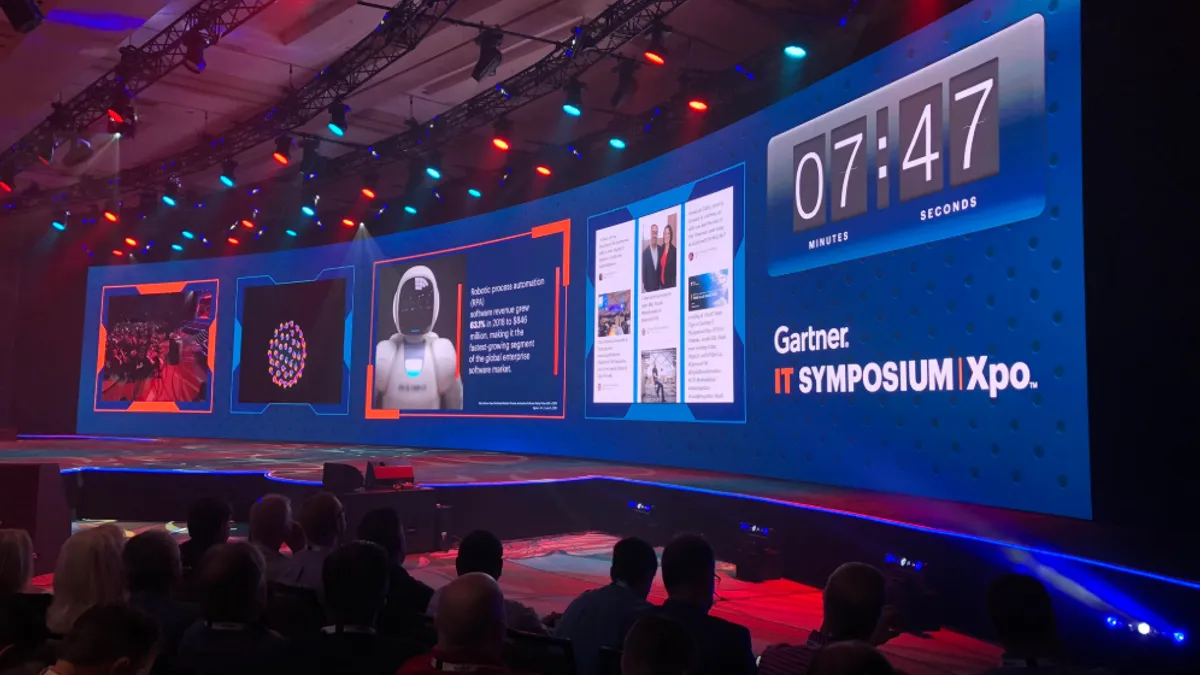Editor's note: To make Gartner's top technology trends more digestible, CIO Dive broke them into two parts. This is the second of two parts. You can read the first, which focuses on technology interacting with people, here.
When "Minority Report" was released in 2002, it felt futuristic. Psychic technology would predict a crime before it was committed and Tom Cruise would go make the arrest.
The movie depicted artificial intelligence pre-determining outcomes, navigated with a multiexperience technology.
Let CIO Dive be the first to tell you: We're not there yet. But rapid advancements in technology platforms are making aspects possible.
AI-based systems are becoming smarter, giving rise to autonomy. Hardware is shrinking but with more memory capabilities, pushing computing to the edge. And the ever-hyped blockchain is finding "practical" applications.
The technological advancements will have a direct impact on the enterprise, and IT decision-makers need to prepare. David Cearley, distinguished VP analyst at Gartner, presented the research firm's top strategic technology trends in an October presentation at Gartner IT Symposium/Xpo in Orlando, Florida.
Here are the advancements in technology IT decision makers need to watch out for:
6. Empowered edge
Advancements in memory and power have pushed computing to the edge, which increases resiliency, responsiveness and reduces costs. Where processes are static in 2019, by 2025 they will be adaptive, on fog or mesh architectures rather than hierarchical architectures.
Where the network is more centralized now, it will move to become a dynamic network, Cearley said.
As more computing moves to the edge, data will be processed in place. By 2023, Gartner projects more than half data will be created and processed "outside the data center or cloud." That's up from less than 10% this year.
Read up:
- Productivity, cost and quality guide IoT investment decisions
- Micron takes on smart manufacturing to fuel memory-hungry sectors
- One way hackers breach a network: Out-of-date office printers
7. Distributed cloud
"We've always considered cloud to be location independent," Cearley said. "Distributed cloud is all about location."
By 2024, the majority of cloud service platforms will have offerings that "execute at the point of need," Gartner says. It solves a number of problems posed by existing hybrid cloud configurations.
Hybrid cloud includes centralized public cloud services with custom private cloud services provided internally to an organization, often in their data centers, according to Cearley. But most organizations don't have a true private cloud, and instead have hybrid IT, which integrates cloud services into internal systems.
That's where distributed cloud comes in, Cearley said. It moves from a private cloud to public cloud architecture where "cloud service providers can provide and manage our information through their cloud services in our data center."
Solving problems around data residency and offering low latency benefits, distributed cloud provides all that "a private cloud can offer without the management headaches of that private cloud."
Read up:
- 5 cloud dos and don'ts
- Hilton turned to the cloud to solve a troublesome room lock problem
- CIOs lean on cloud as C-suite dependence on technology execution grows
8. Autonomous things
Modern automation technologies rely on human assistance, but advancements in technology will allow the shift to conditional automation, which is human-directed. Eventually, full automation with no human control.
While regulation and social acceptance stand in the way, technology is starting to reach a tipping point. By 2025, Gartner projects more than 12% of new vehicles will have "Level 3 or higher autonomous driving hardware capabilities."
As for sleeping in Teslas? "Do not do that," Cearley said.
According to Gartner research, the rise of autonomous things will center around four types of technical capabilities:
-
Perception and interaction: Lidar, radar, vision, etc.
-
Mobility: GPS and geofencing
-
Collaboration: This includes swarm and robot fleet management
-
Manipulation: Computer vision, tactile sensors, etc.
Coordination of autonomous technologies will solve problems currently considered "extraordinarily challenging," such as a robot picking an apple, Cearley said.
Read up:
- From radios to drones: How a humanitarian CIO saves lives with tech
- How 3 CIOs gather — and use — data
9. Practical blockchain
Lest the hype smother industry, there is good news: Blockchain is evolving.
In a movement called "practical blockchain," Gartner expects by 2023 "blockchain-inspired technology" will underlie the movement and tracking of $2 trillion of goods and services every year. It's a far cry from the cryptocraze of the last few years.
In enterprise blockchain public distribution and tokenization are gone, Cearley said. It's already in production in trade, finance, identity management and provenance and other other industries are experimenting.
The research firm still expects true, enhanced blockchain solutions to not appear on the market until about 2030.
Read up:
-
CIO's persistence nets blockchain system for tuna supply chain
-
Most blockchain applications sunk in the 'trough of disillusionment,' Gartner says
-
To keep up with blockchain, colleges look across disciplines
10. AI security
There's a dark side to all the AI industry is banking on: Bad guys and good guys are using it.
By 2022, Gartner expects 30% of cyberattacks to "leverage training data poisoning, AI model theft of adversarial samples."
Training data poisoning injects bad data into systems, augmenting the outcomes, while adversarial samples interject into a machine learning model to produce odd rules, according to Cearley.
Experts expect attackers will use machine learning for nefarious purposes, disrupting an already complex cybersecurity industry.




















